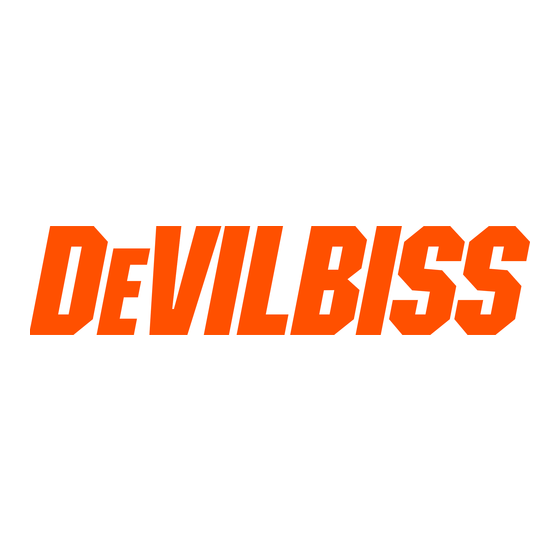Table of Contents
Advertisement
Quick Links
DEVILBISS
SERVICE BULLETIN
SB-2-362
Gun Repair Kit KK-5058-2
JGA-635G COMPliANT HIGH VOLUME lOW PRESSURE
GRAVITY FEED SPRAY GUN
IMPORTANT: Before using this equipment,
read all safety precautions and instructions.
Keep for future use.
DESCRIPTION
The complaint high volume !ow pressure
gravity feed JGA-635G gun is designed to
apply a wide variety of finishing materials.
This gun was manufactured to provide
maximum transfer efficiency by limiting air
cap pressure to
10
psi (complies with rules
issued by SCAQMD and other air quality
authorities).
This gun will produce approximately 10 psi
air cap pressure at
23
psi gun inlet pressure.
An air cap test kit is available (see Acces-
sories) which should be used to insure
10
psi cap pressure is not
exceeded.
Air consumption for the JGA-635G (#350
cap) is 12.5 SCFM at 10 psi air cap pressure.
WARNING
I
Halogenated hydrocarbon solvents -
for example; 1, 1, 1 -trichloroethane
and methylene chloride- can chemi-
cally react with the aluminum
in
this
gun and cause an explosion hazard.
Read the label or data sheet for
the
material
you
intend
to
spray. Do not use spray materials
containing these solvents with this
spray gun.
Important: This gun may be used with
most common coating and finishing
materials. It is designed for use with mildly
corrosive and non-abrasive materials.
If used with other high corrosive or
abrasive materials,
it
must be expected
that frequent and thorough cleaning will
be required and the necessity for
replacement of parts will be increased.
INSTALLATION
For maximum transfer efficiency,
do
not
use more pressure than is necessary to
atomize the material being applied.
Connect the gun to a clean, moisture and
oil free air supply using a hose size of at
least 5/16" 1.0. hose. Do not use
1/4~
1.0.
hose (25' x 1/4" hose at 18 CFM has a
pressure loss of 25 psi. 25' x 5/16" hose at
18 CFM has a pressure loss of 8 psi).
NOTE
Depending on hose length, larger
J.D. hose may be required. Install an
HAV-501 air gauge at the gun handle
and air cap test kit over tip. When
gun is triggered on, adjust regulated
pressure to desired setting to pro-
vide a maximum of 10 psi at the air
cap. Do not use more pressure
than
is necessary
to
atomize the material
being
applied.
Excess pressure will
create additional overspray and re-
duce transfer efficiency.
NOTE
If quick connects are required, use
.o.nl.'i
high flow quick connects ap-
proved for HVLP use such as DeVil-
biss HC-4419 and HC-4719. Other
types will not flow enough air for
proper gun operation.
NOTE
If an air adjusting valve is used at the
gun inlet, use DeVilbiss Model HAV-
500 or HAV-501. Some competitive
adjusting valves have significant
pressure drop that can adversely
affect spray performance. Models
HAV-500
and
HAV-501
have
minimal pressure drop, which is
important for HVLP spraying.
Attach the gravity feed cup to the material
inlet.
NOTE
Protective coating and rust inhibi-
tors have been used to keep the
gun in good condition prior to
shipment. Before using the gun,
flush it with solvents so that these
materials will be removed from
fluid passages.
OPERATION
Mix, prepare and strain the material to be
sprayed according to the paint maufacturer's
·Instructions.
Strain material through a 60 or 90 mesh
screen.
1.
Fill the gravity feed cup with the mate-
ria!. Do not overfill. Make sure that the
cup lid vent hole is clear.
2.
Open the spreader adjustment valve
(10) (Fan) by turning the valve stem
counterclockwise.
3.
Close the fluid needle adjusting screw
(17)
by turning clockwise.
4.
Turn on air supply and set gun inlet
pressure to lowest recommended pres-
sure for material being sprayed. Best
atomization will occur with 10 psig air
cap pressure. However, some materi-
als can be sprayed at lower pressures,
improving transfer efficiency.
5.
Spray a test area byturning fluid needle
adjusting screw ( 17) counterclockwise
until a full coat is obtained.
If the finish is too sandy and dry, the
material flow may be too low for the
atomization air pressure being used .
If the finish sags, there is too much material
flowing for the atomization air pressure
being used.
Both of the above can be corrected by
increasing or decreasing the atomization air
pressure or the material flow. Pattern width
can be altered by turning spreader adjust-
ment valve (10), either clockwise to de-
crease the width or counterclockwise to
increase the width.
See Spray Gun Guide, SB-2-001 latest
revision, for details concerning setup of
spray guns.
PREVENTIVE MAINTENANCE
To clean air cap and fluid tip, brush exterior
with a stiff bristle brush. If necessary to
clean cap holes, use a broom straw or
toothpick if possible.
If a wire or hard
instrument is used, extreme care must be
used to prevent scratching or burring ofthe
holes which will cause a distorted spray
pattern.
To clean fluid passages, remove excess
material from cup, then flush with a suitable
solvent. Wipe gun exterior with a solvent
dampened cloth. Never completely immerse
in solvent as this is detrimental to the lubri-
cants and packings.
NOTE
When replacing the fluidtip orfluid
needle, replace both at the same
time. Using worn parts can cause
fluid leakage. See Chart 1. Also,
(continued on page 3)
Advertisement
Table of Contents













Need help?
Do you have a question about the JGA-635G and is the answer not in the manual?
Questions and answers